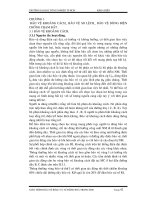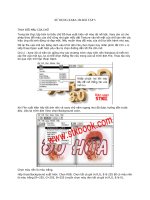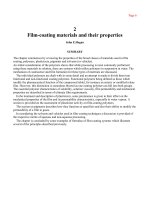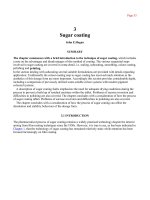Tài liệu Pharmaceutical Coating Technology (Part 3) pdf
Bạn đang xem bản rút gọn của tài liệu. Xem và tải ngay bản đầy đủ của tài liệu tại đây (879.3 KB, 11 trang )
Page 53
3
Sugar coating
John E.Hogan
SUMMARY
The chapter commences with a brief introduction to the technique of sugar coating,
which includes
a note on the advantages and disadvantages of this method of coating. The various sequential steps
involved in sugar coating are covered in som
e
detail, i.e. sealing, subcoating, smoothing, colour coating,
polishing and
printing.
In the section dealing with subcoating several suitable formulations are provided with details regarding
application. Traditionally the colour-coating step in sugar coating has received much attention as the
aesthetics of this dosage form are most important. Accordingly this section provides considerable depth,
including a comparison of previously utilized water-soluble colour systems with modern pigment
coloured systems.
A description of sugar coating faults emphasizes the need for adequate drying conditions during the
process to prevent a build up of residual moisture within the tablet. Problems of sucrose inversion and
difficulties in polishing are also covered. The chapter concludes with a consideration of how the process
of sugar coating tablet. Problems of sucrose inversion and difficulties in polishing are also covered.
The chapter concludes with a consideration of how the process of sugar coating can affect the
dissolution and stability behaviour of the dosage form.
3.1 INTRODUCTION
The pharmaceutical process of sugar coating remains a widely practised technology despite the interest
arising from film-coating techniques since the 1950s. However, it is true to say, as has been indicated in
Chapter 1
, that the technology of sugar coating has remained relatively static while attention has been
focused increasingly on film coating.
Page 54
3.2 BASIC PROCESS REVIEW
Unlike film coating, sugar coating is still a multistep process. Its use of labour is more intensive than in
film coating and process operators require a fair degree of skill but less than in former days when more
traditional methods prevailed.
In suitable sugar-coating equipment the tablet cores are successively treated with aqueous sucrose
solutions which, depending on the stage of coating reached, may contain other functional ingredients,
e.g. fillers, colours, etc. The build up of coating material is due to a transference of coating medium
from one tablet to another. Typically a single liquid application will be made which will be allowed to
spread over the entire tablet bed utilizing the mixing capability of the particular equipment. At this
point, drying, usually in the form of heated air, will be used to dry the application. The whole cycle will
then be successively repeated.
In this respect sugar coating differs from film coating as in this process each tablet passes through a
zone of application which is subject to rapid and continuous drying.
3.3 ADVANTAGES OF SUGAR COATING
Despite the undoubted disadvantages of the sugar-coating process in terms of process length, intensive
operator attention and so forth, it is important to be aware that sugar coating can have certain
advantages:
3.4 THE STAGES IN SUGAR COATING
3.4.1 Sealing
It is necessary to protect the tablet core from the aqueous nature of sucrose applications to follow.
Sealing also prevents certain types of materials from migrating to
• It utilizes inexpensive and readily available raw materials.
• Constituent raw materials are widely accepted—no regulatory problems.
• Modern, simplified techniques have greatly reduced coating times over traditional sugar-coating
methods.
• No complex equipment or services are required.
• The process is capable of being controlled and documented to meet modern GMP standards.
• Simplicity of equipment and ready availability of raw materials make sugar coating an ideal
coating method for developing countries.
• The process is generally not as critical as film coating; recovering and reworking procedures are
usually possible.
• For high humidity climates, it generally offers a stability advantage over film-coated tablets.
• Results are aesthetically pleasing and have wide consumer acceptability.
• Tablet cores may generally be softer than those demanded by film coating, especially those for
aqueous film coating.
Page 55
Fig. 3.1 The stages in sugar coating.
the tablet surface and spoiling the appearance, e.g. oils, acids, etc. This is unfortunately an organic
solvent-dependent step in an otherwise aqueous process.
A film of water-impervious polymer is built up using materials such as:
Shellac has all the disadvantages of a natural material (see Chapter 2
for a more detailed description),
the other polymers used tend to be those which have an additional use as enteric-coating materials so
that they should be applied only in sufficient quantity to form an efficient seal. A lamination process,
whereby an application of sealant is followed by an application of dusting power, e.g. talc, is nearly
always used.
3.4.2 Subcoating
During the sugar-coating process the increase in weight achieved can be 30–50% of the weight of the
original tablet core. Much of the added weight is applied at the subcoating stage. Subcoating serves to
confer on the tablet core a perfectly rounded aspect.
The ideal shape for sugar coating is a deeply convex core with minimal edges (Fig. 3.2
). This
condition will obviously require less coating material than where the tablet edge is comparatively thick.
Seager
et al. (1985) have cautioned that deeply convex tablet cores may not be exactly ideal as their
crowns tend to be soft. Basically there are two methods:
• Shellac
• CAP
• PVAP
• Zein.
Page 56
Lamination process
Below are illustrated two typical examples of binder solution formulations for subcoating, together with
their corresponding dusting powder formulations. The principle of the process is that a volume of binder
solution is applied to the sealed cores in the coating pan. Once this has spread over the tablet bed an
application of powder is dusted into the pan, and when this has evenly distributed itself over the
contents, drying air is applied. The drying air process needs to be carefully controlled to prevent too
rapid evaporation of the water. The objective should be to create as smooth a coat as possible in order to
reduce the time for smoothing the coat in the final stages of process. Excessively rapid drying results in
a very uneven surface. Too low an evaporation rate gives rise to a lengthy process and the danger of
cores adhering together.
Fig. 3.2 Ideal and non-ideal tablet core shapes for sugar coating.
Page 57
Binder solution formulation:
Dusting powder formulation:
Features of the lamination process
Disadvantages of the lamination process
Suspension process
In recent years, automation in the sugar-coating process has required the use of a liquid subcoat. These
are generally suspensions of the filler materials, e.g. calcium carbonate, talc, sucrose in the gum
solutions. The example quoted below is suitable for hand panning or automatic methods with a little
modification. A description of a typical sugar-coating pan is given and the latest type of side-vented
coating pans is given in Chapter 8
. The system contains only approximately 23% water and
consequently dries quickly.
Formulae
Quantities are for a batch of 250 000 tablets having an average weight of 200 mg and providing a
batch weight of 50 kg in a 4 ft diameter pan.
Coating powder:
I(% w/w) II(% w/w)
Gelatin 3.3 6.0
Gum acacia (powdered) 8.7 8.0
Sucrose 55.3 45.0
Water to 100.0 to 100.0
I(% w/w) II(% w/w)
Calcium carbonate 40.0 —
Titanium dioxide 5.0 1.0
Talc 25.0 61.0
Surcose (powdered) 28.0 38.0
Gum acacia (powdered) 2.0 —
• The use of a binder solution with gum binds the powder application on the tablet.
• Utilizes inexpensive ingredients with high opacity.
• In skilled hands a very fast build up to the required shape is obtained.
• The use of free dusted powders tends to create clean-up problems.
• Difficult to control in documentary terms as frequently volumes note weights of powders are
specified.
• Difficult to automate as both powders and liquids are involved.
Calcium carbonate, light 6.8 kg
Talc 1.8 kg









